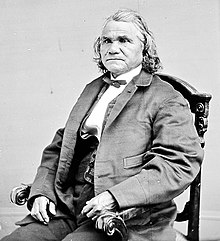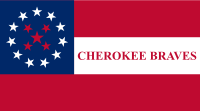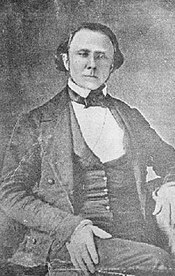Cherokee in the American Civil War
From Wikipedia, the free encyclopedia
Jump to navigation Jump to search

Confederate Brigadier General Stand Watie, the only American Indian to reach the rank of general in the Civil War on either side.
The Cherokee in the American Civil War were active in the Trans-Mississippi and Western Theaters. In the east, Confederate Cherokees led by William Holland Thomas hindered Union forces trying to use the Appalachian mountain passes of western North Carolina and eastern Tennessee. Out west, Confederate Cherokee Stand Watie led primarily Native Confederate forces in the Indian Territory, in what is now the state of Oklahoma.[1] The Cherokee partnered with the Confederacy in order to get funds, as well as ultimately full recognition as a sovereign, independent state.[2]
Contents
- 1 Background
- 2 Trans-Mississippi Theater
- 3 Western Theater
- 4 Aftermath
- 5 See also
- 6 Notes
- 7 Further reading
Background
Before Indian Removal, the Cherokee Nation was centered in and around the Blue Ridge Mountains—southwestern North Carolina, southeastern Tennessee, western South Carolina and northeastern Georgia. The Cherokee attempted to address their grievances by taking their problems to the American Federal judicial system. In 1830, a delegation led by Chief John Ross defended Cherokee rights before the U.S. Supreme Court in Cherokee Nation v. Georgia. The Indian cases set a precedent in Indian Country but was in vain as the Cherokee Nation was set upon the Trail of Tears. After the removals, the Cherokee Nation was found west of the Mississippi River, and some Cherokee were still found in the Blue Ridge Mountains.
The Cherokee blamed the federal government and former United States President Andrew Jackson for the Trail of Tears. They also had adopted "Southern ways" before their removal from their Appalachia home. A few of them had owned slaves. Therefore, the western Cherokee already disliked the north when in 1860 William Seward, campaigning on behalf of Abraham Lincoln, said that Lincoln would open the Indian Territory for white settlement.[3]
Trans-Mississippi Theater


The Cherokee Braves Flag, as flown by Cherokee General Stand Watie.
Chief of the Cherokee John Ross was adamant that the Union was not dissolved. However, another leader of the Cherokee, Stand Watie, joined the Confederate cause, and on June 1, 1861, began recruiting for all-Indian units that became part of the Confederate army. Full-blooded Cherokee tended to support Ross (who was primarily Scottish) while the mixed-blooded Cherokee supported the 3/4 Cherokee Stand Watie.[4] Stand Watie in 1862 was elected Chief of the newly declared Southern Cherokee Nation.
For the duration of the war, a series of small battles and constant guerrilla warfare were waged by Cherokee in the Indian Territory. Stand Watie officially became the last Confederate general to end fighting on June 25, 1865 at Fort Towson, in the southeast portion of the Indian Territory. The terms of the armistice allowed Watie and his command, the First Indian Brigade of the Army of the Trans-Mississippi, to demobilize rather than surrender and go home with their arms.[5]
Organization
During the Civil War, the Cherokee Nation had approximately 21,000 members with 3,000 of them serving in the Confederacy as soldiers.[6]
- First Cherokee Mounted Rifles
- 1st Regiment of Cherokee Mounted Volunteers
- 2nd Regiment of Cherokee Mounted Volunteers
- 3rd Cherokee Regiment of Volunteer Cavalry
- Cherokee Regiment (Special Services), CSA
- 1st Cherokee Battalion of Partisan Rangers
- 2nd Cherokee Artillery
- Cherokee Special Services Battalion
- Scales' Battalion of Cherokee Cavalry
- Meyer's Battalion of Cherokee Cavalry
- Cherokee Battalion of Infantry
- 1st Squadron of Cherokee Mounted Volunteers
Battles and Skirmishes
- Battle of Wilson's Creek (August 10, 1861)
- Battle of Bird Creek (December 9, 1861)
- Battle of Chustenahlah (December 26, 1861)
- Battle of Pea Ridge (March 6–8, 1862)
- Battle of Prairie Grove (December 7, 1862)
- Battle of Honey Springs (July 17, 1863)
- First Battle of Cabin Creek (July 1, 1863 – July 2, 1863)
- Ambush of the steamboat J. R. Williams (June 15, 1864)
- Battle of Fort Smith (July 31, 1864)
- Second Battle of Cabin Creek (September 19, 1864)
Western Theater

William Holland Thomas was the commander of the well-known legion.
Thomas' Legion, led by William H. Thomas, a European-American who was adopted Cherokee, were originally stationed outside Knoxville, Tennessee at Strawberry Plains, Tennessee. Their primary duty was to protect the Alum Cave, and harass Union troops that invaded Tennessee. While briefly working around Chattanooga, Tennessee in June 1862, Thomas personally captured a Union Soldier, after which each of his men vowed to capture at least one "Yankee" before the war was over.[7]
The Legion would become infamous due to their actions on September 15, 1862.[8] While trying to stop a Union advance through Baptist Gap, a popular leader among the Cherokee, Astoogahtogeh, was killed leading a charge. Enraged, the remaining Cherokee were driven to avenge him. In retaliation for Astoogahtogeh's death, the Cherokee scalped the dead Union soldiers after the battle. After the event was reported in newspapers, Union soldiers would fear the Cherokee, but Thomas feared for the reputation of the Cherokee, as he did not want his people to be seen as barbaric. The scalps were sent to be buried with the soldiers they originally came from.[7]
After a number of Thomas' men were captured in February 1864, some were convinced by the Union that they were fighting for slavery, and thereafter fought for the Union. Others convinced their captors they also would defect to the Union side, but instead went back to Thomas and told him Union officials offered $5,000 for Thomas' scalp. After this, many of his men were sent to fight in Virginia, some of whom were present at Appomattox Court House for General Robert E. Lee's surrender.[9] The rest of the Legion continued to fight until surrendering along with the commanding officer of the District of Western North Carolina to the Union commander they had captured on 10 May 1865.
Organization
In May 1861, William H. Thomas began recruiting Cherokees from the Quallatown, North Carolina area.[10] The first two companies were composed mostly of Indian soldiers. They were called the Junaluska Zouaves.[10] Thomas' Confederates were sometimes referred to as Thomas' Legion or Thomas' Legion of Cherokee Indians and Highlanders. They were later designated as the 69th North Carolina Regiment.
- 69th North Carolina Regiment[11]
- Field & Staff: Colonel William H. Thomas, Lieutenant Colonel James R. Love, Major William W. Stringfield, Luther C. May (Adjutant), James W. Terrell (A.Q.M.), John W. Lawing (Surgeon), and Hezekiah West (Chaplain)[11]
- Companies: Company A (Captain James W. Terrell), Company B (Captain G. M. Hanks), Company C (Captain Elisha G. Johnson), Company D (Captain William B. Love), Company E (Captain Julius M. Welch), Company F (Captain J. M. McConnell), Company G (Captain Daniel G. Fisher), Company H (Captain Thomas J. Cooper, Captain James W. Cooper), Company I (Captain Willis Parker, Captain Joseph A. Kinsey), Company K (Captain Thomas A. Butler)[11]
- Total: 1,125 men[12]
Aftermath

Cherokee Confederates reunion in New Orleans, 1903.
The eastern Cherokee faced a severe smallpox outbreak following the war. Thomas and many of his followers were deeply in debt, to the point that the federal government recognized the eastern tribe as separate from the western tribe, and filed a lawsuit against the Cherokee's creditors, in effect leaving the protection of the Cherokee to the federal government.[9]
In the west, at the end of the war, with the Union victorious, the Union Cherokee established policies that confiscated land from the Confederate Cherokee.[citation needed] The Federal government promised the Confederate Cherokee that the laws promoting the confiscation would be annulled. This was due to Indian Commissioner D.N. Cooley, who saw opportunities in splitting the factions of the Cherokee, as represented by Ross and Watie. Cooley even went as far as to portray Ross as a traitor, when Ross had always been a Union advocate. The Cherokee were forced to adopt their slaves into the tribe, and to allow settlement of their lands by whites. In effect, due to the Cherokee split and the maneuverings of Cooley, the Cherokee suffered the worst of Reconstruction.[5][13]
Monuments
Monuments were dedicated for the Cherokee's wartime participation in the early 20th century.[14]
See also
- Indian Territory in the American Civil War
- Native Americans in the American Civil War
- Catawba in the American Civil War
- Choctaw in the American Civil War
- Seminole in the American Civil War
- Cherokee military history
- Southern Cherokee Nation of Kentucky
Notes
- "Watie, Stand (1806–1871)" Archived August 5, 2011, at the Wayback Machine Oklahoma Historical Society's Encyclopedia of History and Culture; retrieved 31 Aug 2011
- Tindle, James (2019). ""Perpetual Peace and Friendship": The Cherokee-Confederate Coalition in the American Civil War".
- Gibson p.117
- Gibson p.119
- Confer pp.150,153
- Hauptman, Laurence M. (1995). "The General, The Western Cherokee and the Lost Cause". Between Two Fires: American Indians in the Civil War. The Free Press. p. 42.
- Rozema p.48
- Ferguson, Robert. "Southeastern Indians During The Civil War". The Backwoodsman. Vol. 39 no. 2 (Mar/Apr 2018 ed.). Bandera, Texas: Charlie Richie Sr. pp. 63–65. Retrieved February 19, 2018.
- Rozema p.49
- Hauptman, Laurence M. (1995). "Confederate Rangers of the Smokies, Wil-Usdi's Eastern Band of Cherokee". Between Two Fires: American Indians in the Civil War. The Free Press. p. 108.
- Moore, John W. (1882). "Sixty-Ninth Regiment--Infantry". Roster of North Carolina Troops in the War Between the States, Vol. 4. Ashe & Gatling, State Printers and Binders. p. 151.
- Clark, Walter (1901). "Sixty-Ninth Regiment". Histories of the Several Regiments and Battalions from North Carolina in the Great War 1861-'65, Vol. III. Nash Brothers, Book and Job Printers. p. 731.
- Gibson pp.128,129
- McCleland, Jacob (August 31, 2017). "As Cities Remove Confederate Monuments, Cherokees Grapple With Civil War Past". Retrieved September 7, 2017.
Further reading
- Confer, Clarissa (2007), The Cherokee Nation in the Civil War, University of Oklahoma Press, ISBN 978-0-8061-3803-9
- Dale, Edward Everett (1947). "The Cherokees in the Confederacy". The Journal of Southern History. 13 (2): 159–185. doi:10.2307/2197976. JSTOR 2197976.
- Fisher, Paul Thomas. "Confederate empire and the Indian treaties: Pike, McCulloch, and the Five Civilized Tribes, 1861–1862" (MA thesis Baylor U. 2011). online; bibliography pp 107–19.
- Gibson, Arrell (1981), Oklahoma, a History of Five Centuries, University of Oklahoma Press, ISBN 0-8061-1758-3
- Hauptman, Laurence M. (1995). Between Two Fires: American Indians in the Civil War (First ed.). New York: Free Press. ISBN 9780029141809.
- Johnston, Carolyn (2003). Cherokee Women In Crisis: Trail of Tears, Civil War, and Allotment, 1838-1907. The University of Alabama Press. ISBN 9780817384661.
- Moore, Jessie Randolph. "The Five Great Indian Nations: Cherokee, Choctaw, Chickasaw, Seminole, and Creek: The Part They Played in Behalf of the Confederacy in the War Between the States." Chronicles of Oklahoma 29 (1951): 324-336.
- Rozema, Vicki (2007), Footsteps of the Cherokees, John F. Blair, ISBN 978-0-89587-346-0
- Thomsen, Paul A. (2004). Rebel Chief: The Motley Life of Colonel William Holland Thomas C.S.A. (1st ed.). New York: Forge Books. ISBN 0765309580.
'아메리카' 카테고리의 다른 글
| <펌>Robert E. Lee (0) | 2020.07.24 |
|---|---|
| <펌>Abraham Lincoln (0) | 2020.07.24 |
| <펌> Russian colonization of the Americas (0) | 2020.07.23 |
| <펌> Dutch colonization of the Americas (0) | 2020.07.23 |
| <펌> Portuguese colonization of the Americas (0) | 2020.07.23 |
